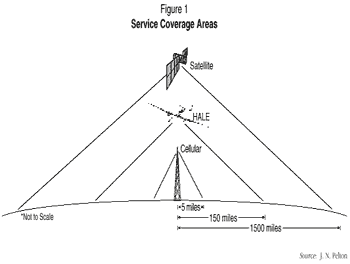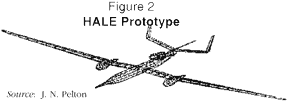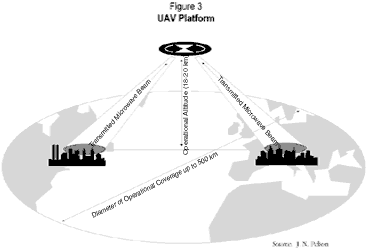
For a number of years, these limitations, as they related to broadcast satellite operation and telephone service between fixed satellite antennas, were overcome and minimized, but when the idea of using satellite communications to interconnect handheld units for mobile communications arose, the "one size fits all mentality" simply broke down. In what might be called the "Goldilocks Realization," satellite planners began to think and plan new satellite architectures in medium or low earth orbit. The ideas that began to surface suggested that, with lower orbits, one could minimize transmission delay, overcome huge path losses, re-use satellite frequencies much more intensively, and achieve a much more favorable look angle to overcome problems of buildings, mountains, and trees interrupting the signal.
There were also a number of others such as the Ellipso, Aires, Orbcom, Gonets, etc. The checklist on these systems looked very good:
| Small Hand Held Transceivers | -» | YES |
| Good Look Angles | -» | YES |
| Modest Transmission Delay | -» | YES |
| Small Transmission Path Losses | -» | YES |
| Intensive Frequency Re-Use Possible | -» | YES |
But there is a kicker at the end -- huge capital investments in large satellite fleets and huge launch costs. This is the great challenge that only the highly challenging and unconventional system has claimed to overcome by resorting to large economies of scale. With many billions of dollars at stake, some others have said the following: If the GEO systems have major problems and the LEO systems seem to be too costly, is there another solution? Is there a Goldilocks solution that for some telecommunications can be "just right?"
At least some unconventional thinkers have started with "ideal" solutions, and then tried to work back to the magic answer. The starting point in such an analysis might say: If the objective is to provide telecommunications services to a sprawling urban area for perhaps mobile services, cable television service, or broadband links to the home and business, what kind of a "satellite" would I like to see? The answer might well be as follows: geosynchronous position, highly vertical look angle, short transmission path, high capacity or throughput, multiple frequency re-use, fully spared, easily retrofitable, good geographic coverage of the entire urban area, and reasonably low cost.
The remarkable fact is that such a new technology, known variously as Unattended Autonomous Vehicles (UAVs), Remotely Piloted Vehicles (RPVs), High Altitude Long Endurance (HALE) platforms, or Atmospheric Satellites, is now on the horizon in a figurative and literal sense. Why now?
The burst of development that seemingly will give birth to several new corporations to develop and deploy this technology comes from the convergence of several enabling technological developments.
ENABLING TECHNOLOGIES
The first of these technologies is the development, for military applications, of vehicles that can fly under robotic control. This technology has now evolved to the level that it seems ready for commercial use. These systems are increasingly reliable. Further, since there is no pilot and they can, in emergencies, be systematically destroyed, the requirements for reliability do not have to be the same as for piloted craft.
The second of these technologies is the development of new antenna systems. Phased-array multi-beam antenna systems on the UAV platforms and low cost, but high performance patch antennas on the ground can allow very high efficiency performance. Multi-beam systems of 10 to perhaps even 100 beams may be possible. This could allow platforms in proto-space to provide systems of 100,000 cellular telephone lines that could support up to two million subscribers.
Third on the list is breakthroughs in composite structure airframes of great strength and low weight, plus new high-efficiency propulsion systems and power generation and storage systems. Pioneers such as Bert Rutan, head of Scaled Composites and builder of the Challenger that circumnavigated the world nonstop, and Paul McCready, designer of the solar-powered Pathfinder and the Gossamer Albatross, have both pointed the way to commercial UAV craft that can maintain long-term telecommunications missions.
There are other factors, but these are the big three that make these atmospheric satellites in proto-space suddenly feasible and soon commercially viable. The remarkable thing is that these systems could be built and deployed before many of the proposed low earth orbit satellite systems.
SERVICE COVERAGE AREA
Does this mean that the UAV or HALE platforms will replace and supplant communications satellites of the 21st century? The answer is clearly no. The truth is that there are clear market niches:
Figure 1 illustrates the important service coverage area between radio towers and satellite coverage where UAV presumably can and will reign supreme. If one wished to create a cellular or personal communications service for any of the world's largest cities, the proto-space platform would be hard to beat.

MARKET OPPORTUNITIES
If one assumes that there is an important and potentially very broad market for this type of telecommunications platform which could well grow into a multi-billion dollar industry, then what exactly is it? How does it work?
The concept is actually very straightforward. The plan is for design platforms that resemble very high altitude jets or airplanes that are optimized for very long duration missions. This means very long and slender wings that can function as fuel tanks and with specially designed long span propeller systems and jets designed to "breathe" very thin air. In the longer term, such aspects as solar cell power, fuel cell storage systems, and even supplemental microwave power beamed from the ground may perhaps join the technology mix. The first platforms will likely fly four-day missions, perhaps with fully spared and operational systems also aloft at the same time and with active backup craft ready to be instantly deployed. The consumption of fuel will require this limited cycle time in actual service operation. The advantage is that frequent checks of electronic equipment, upgrades, and servicing is possible, but the continual cycle of the platforms into their operating locations increases flight risks and drives up operating costs.
It is believed that, in time, much longer cycle times will be achieved. Figures 2 and 3 illustrate what these HALE or UAV platforms might look like and how they would operate.


From an economic perspective, these platforms can be quite competitive over either radio towers or satellites for the coverage areas indicated in Figure 1. There are other concerns as well. One is that of environmental effects. These composite structure platforms are so light and fuel efficient that they consume an amazingly small amount of fuel. In fact, the operation of a UAV platform for a year is equivalent to less that two flights of a 747 from the United States to Japan. In time, the development of solar and fuel cell platforms would be even more environmentally benign.
In terms of regulations, the location of the platforms above 13 miles altitude is crucial, since this is the height at which regulated air space by the FAA in the United States and by other bodies elsewhere ends. Guidelines for UAV operations are being developed to govern the safe deployment and landing of the platforms and to regulate their long-term safe operation.
It is likely that these will be adopted by 1996 in the United States and by a number of other countries around the world in following years.
APPLICATIONS
The range and versatility of UAV platforms applications is, in fact, impressively broad. The possible applications for mobile services are to support conventional cellular telephone service in the 800 MHz to 900 MHz bands for enhanced specialized mobile radio, or, the most cost effective of all, for Personal Communications Service (PCS). PCS is quite attractive since there are many more cells and cell interconnections involved, and this can all be provided by a single platform. Locating dozens of PCS base station cell sites, deploying the antenna masts, and providing back haul links to switching centers are very complex and expensive operations which UAV platforms can offer on an integrated basis.
UAV platforms, because of their kilowatts of power, wide coverage areas, and ability to operate on any authorized frequency, can provide:
There really are few telecommunications within the magic 300-mile bullseye where UAVs do not produce a highly cost-effective alternative. To illustrate the type of telecommunications coverage that is possible: The area of illumination with a 5% look angle is sufficient -- with only one or two operating systems -- to cover Taiwan, South Korea, or 19 out of 26 Latin American and Caribbean nations.
If this technology develops as planned and demonstrates reliable operation, it could, by the early 21st century, become a billion dollar industry that makes a key contribution to the world of telecommunications. It could well make its first important contribution in developing and industrializing countries without their own extensive terrestrial infrastructure already in place. Countries such as Thailand, Korea, and Turkey have deployed, or will shortly deploy, their own domestic satellite communications systems at costs measured in hundreds of millions of dollars. For investments that are almost two orders of magnitude less, less affluent developing countries can deploy the latest in digital telecommunications technology for data, voice, television, and even multimedia services.
Is the future of high-flying UAV platforms restricted to just telecommunications? No, the opportunities are actually quite broad. There are literally dozens of attractive possible applications. These include the deployment of systems for fire detection, safety alerts and crime monitoring, emergency and disaster communications, and other similar applications. One could also deploy free-flying platforms that would have enormous range. These could be used for remote sensing to detect crop or forestry disease, monitor the oceans, and survey for mineral and petroleum reserves, as well as perform other detection duties. These free-flying platforms could work in conjunction with satellite systems for precise and targeted observations based on analysis of satellite-based sensing data. One could also deploy a constellation of these free flyers to obtain near instantaneous news gathering information for organizations such as CNN International, Visnews, or ITN. Within minutes or hours, such a UAV news gathering remote television system could provide coverage of volcano eruptions, tidal waves, fires, or other fast-breaking news events.
One of the most fascinating possibilities would be for remotely piloted air freighting. UAV free flyers could convey cargo back and forth across the oceans on unmanned proto-space air freighters adapted to operate in the upper atmosphere. There would be large fuel savings since they could fly at optimal speeds, and labor costs would be reduced by an order of magnitude. In the 2lst century, operations such as FedEx, UPS, and DHL could be radically transformed.
At one time we used to say that the sky is the limit, but with Unattended Autonomous Vehicles and High Altitude Long Endurance platforms, the limit extends at least well into proto-space. Who knows -- the next application in proto-space may well even be space tourism.